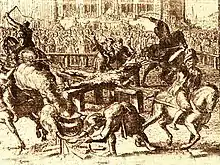Michał Piekarski | |
|---|---|
| Born | unknown; before 1597 |
| Died | 27 November 1620[1] Warsaw, Polish–Lithuanian Commonwealth |
| Nationality | Polish |
| Criminal charge | Attempted regicide |
| Penalty | Tortured and dismembered |
Michał Piekarski (Polish pronunciation: [mixaw piɛkarski]; before 1597 – 27 November 1620), also known as Michael Piekarski, was a Polish petty nobleman and landowner, who attempted to assassinate king Sigismund III in 1620.[1]
Biography

Michał Piekarski, the son of Stanisław, as a child was involved in an accident during which he severely injured his head and began to suffer mentally.[2] He was often described as an impetuous melancholic and an eccentric man. As the illness systematically progressed, Piekarski was temporarily isolated and forbidden from rightfully managing his estates at Binkowice in southeastern Poland where he was most likely born.[3]
In May 1610, when king Henry IV of France was successfully assassinated by François Ravaillac, Piekarski, then still a young man, decided to kill Sigismund III of Poland. He eagerly waited and prepared for almost 10 years before attempting it. He was also drawn towards assassinating the monarch by the failed Zebrzydowski Rebellion, which was organised by the nobility against Sigismund.[4]
Throughout his life Piekarski remained a pious Calvinist. All Protestants and Calvin followers became targeted by Sigismund and the Catholic Church during the Counterreformation in Poland.[4] Rumours circulated that it was the Radziwiłł magnate family who played a pivotal role in attempting to murder the king due to religious persecution and their fervent support for Protestantism.[4] These claims, however, were never verified.
Assassination attempt
The attack occurred on 15 November 1620 at approximately 9:00 in the morning when Sigismund was to attend mass at Saint John's Cathedral in Warsaw. The king and a few other members of court as well as guards were walking in a small royal procession to the cathedral from the Royal Castle, which was connected to the temple by a narrow passage, usually unavailable for local townsfolk. Other sources claim that the king was only accompanied by a few men or advisers, and that the manner in which they were to attend mass was casual.[4]
When the cortege approached the end of the corridor, Piekarski leaped out and stabbed the monarch twice using a czekan (light war axe), firstly in the back and then in the cheek, and striking him in the arm. He was overpowered by either the guards or Court Marshal Łukasz Opaliński, who also shielded Sigismund.[5] Some historians question the presence of any guards in the procession. The perpetrator was also hit in the skull with a sabre by Prince Władysław, which allowed him to be captured and held down.[5]
The assassination attempt quickly became a major event; chaos erupted when false rumours spread that the king had been murdered as his clothes were stained in blood. Initially, the local townspeople thought that the city was being invaded by the Tatars.[6]
Execution

On 20 November, the Sejm (Parliament) presented a verdict sentencing Piekarski to death without trial. The main charge was attempted regicide, which Piekarski did not deny. He was not fond of the king and blatantly offended the Court Marshal and the noble jury. The Parliament ordered the confiscation of his estates; the repugnance of the magnates towards Piekarski was so great that his native village of Binkowice was to be sacked and burned to the ground.[4] It was later spared and the estates were given to a noble who had aided Sigismund during the assassination.
The execution took place on 27 November and an executioner was brought in for the occasion from Drohiczyn.[7] Per sentence, Piekarski was driven around Warsaw and his body was slowly torn up with heated pliers while he was still alive on the cart. He was then placed on a platform situated in an area called Piekiełko (Devil's Den) near the Old Town where his right hand was cut off and incinerated. Towards the end of his tortures Piekarski was tied by his legs and arms and dismembered by horses.[8]
Legacy
A popular Polish saying "pleść jak Piekarski na mękach", roughly translated as "to blather like Piekarski during torture", surfaced shortly before Piekarski's execution when he confessed his sins in an unorderly, confusing and lifeless manner. The expression is still used nowadays.[9][10][11][12]
References
- 1 2 Podhorodecki, Leszek (30 April 2019). "Chocim 1621". Bellona. Retrieved 30 April 2019 – via Google Books.
- ↑ "Niedoszły królobójca Michał Piekarski i jego zamach (cz. 1) - HISTORIA.org.pl - historia, kultura, muzea, matura, rekonstrukcje i recenzje historyczne". 20 February 2013. Retrieved 30 April 2019.
- ↑ "Kalendarz Warszawski na rok 1946: rocznik poświecony Warszawie, cierpieniom i bohaterstwu stolicy Warszawie wczorajszej, dzisiejszej, Warszawie jutra". Towarzystwo gniazd sierocych. 30 April 2019. Retrieved 30 April 2019 – via Google Books.
- 1 2 3 4 5 "Piekarski". kuriergalicyjski.com. Retrieved 30 April 2019.
- 1 2 "Uwagi Machiavella wysnute z Liwiusza historyi rzymskiej0: Z oryginału włoskiego przełożył A. Sozański". Boldoni, 2: Dr.:] Czaiński. 30 April 1875. Retrieved 30 April 2019 – via Google Books.
- ↑ "Zamach na króla Zygmunta III Wazę". www.wilanow-palac.pl. Retrieved 30 April 2019.
- ↑ "Szaleniec czy desperat?". www.sprawynauki.edu.pl. Retrieved 30 April 2019.
- ↑ Besala, Jerzy (1 January 2003). Tajemnice historii Polski. Wydawn. Podsiedlik-Raniowski i Spółka. ISBN 9788373414341. Retrieved 30 April 2019 – via Google Books.
- ↑ "Jak Piekarski na mękach". PolskieRadio.pl. Retrieved 30 April 2019.
- ↑ "Bredzić jak Piekarski na mękach. Etymologia, pochodzenie frazeologizmu - Sekcja dla tych, których do szewskiej pasji doprowadzają zawiłości semantyczne polszczyzny. Od czasów Popiela wiadomo, że kto wiesza psy na języku zamiast poznawać historię powstania i znaczenie frazeologizmów... - Edusens.pl". www.edusens.pl. Retrieved 30 April 2019.
- ↑ ""Pleść jak Piekarski na mękach". Krwawa geneza słynnego powiedzenia". 27 November 2017. Retrieved 30 April 2019.
- ↑ "Warszawa - Plecie, jak Piekarski na mękach. Atrakcje turystyczne Warszawy. Ciekawe miejsca Warszawy". www.polskaniezwykla.pl. Retrieved 30 April 2019.